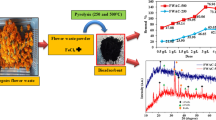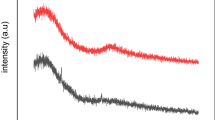Abstract
In the present study sodium carbonate modified Bambusa tulda was utilised for the removal of crystal violet dye from aqueous solution. The functional group characterization and the surface morphology was done by Fourier Transform Infrared Spectroscopy (FTIR) and Scanning Electron Microscope (SEM). It confirms the hydroxyl groups and carboxyl group present on the surface of modified Bambusa tulda. The optimum condition for the removal of crystal violet was taken place at pH 7, 200 rpm, dose at 10gm/l, initial concentration 50 mg/l, at equilibrium time 60 minutes and 298 K temperature with maximum adsorption capacity of 20.84 mg/gm. The adsorption of crystal violet by modified Bambusa tulda best fits in Langmuir isotherm model with R2 value 0.924 and Pseudo 2nd order rate equation model with R2 value of 0.999. Other parameters like isosteric heat analysis, thermodynamics profile and activation energy were investigated. Thus, modified Bambusa tulda can be an efficient and economically used as an alternative for activated carbon for the removal of crystal violet from waste water.
Similar content being viewed by others
References
Abuh, M. A., Akpomie, G. K., Nwagbara, N. K., and Nwafor, E. C. (2013). “Equilibrium isotherm studies for the biosorption of Cu (II) and Zn (II) from aqueous solution by a unmodified lignocellulosic fibrous layer of palm tree trunk-Single component system,” Int. J. Engineering Science Invention, Vol. 2, No. 6, pp. 27–39.
Adedamola, T. O. and Olugbenga, S. B. (2017). “Liquid phase adsorption of Congo red dye on functionalized corn cobs,” Journal of Dispersion Science and Technology, Vol. 38, No. 9, pp. 1285–1294.
Ahmad, R. (2009). “Studies on adsorption of crystal violet dye from aqueous solution onto Coniferous Pinus Bark Powder (CPBP),” Journal of Hazardous Materials, Vol. 171, Issue 1–3, pp. 767–773.
Aljeboree, A., Abbas, N., Ayad, J., and Alkaim, F. (2014). “Kinetics and equilibrium study for the adsorption of textile dyes on coconut shell activated carbon,” Arabian J Chemistry, Vol. 126, No. 10, pp. S3381–S3393, DOI: 10.1016/J.ARABJC.2014.01.020.
Ashfqaq, T., Gardazi, S., Sherazi, T., Ali, M., Rashid, N., and Bilal, M. (2016). “Equilibrium kinetic and thermodynamic studies of Cr(VI) adsorption onto a novel adsorbent of Eucalyptuscamaldulensis waste: Batch and column reactors,” Korean Journal of Chemical Engineering., Vol. 33, No. 10, pp. 2898–2907.
Asma, S., Sharif, M., and Iqbal, M. (2010). “Application potential of grapefruit peel as dye sorbent: Kinetics, equilibrium and mechanism of crystal violet adsorption.” Journal of Hazard Material, Vol. 179, Nos. 1–3, pp. 564–572, DOI: 10.1016/J.JHAZMAT.2010.03.041.
Babu, I., Lokeshwaran, S., Kumar, J. S., Sundar, K. S., Srinivasan, V. (2016). “Removal of crystal violet dye from water using banana peel charcoal and AMPS-g-Banana peel charcoal hydrogels: A comparative study,” South Asian Journal of Engineering and Technology, Vol. 2, No. 24, pp. 155–168.
Chan, W. H., Cheung, S. J., and McKay, G. (2006). “Error analysis of adsorption isotherm models for acid dyes onto bamboo-derived activated carbon,” Chinese Journal of Chemical Engineering, Vol. 20, No. 3, pp. 535–546, DOI:10.1016/S1004-9541(11)60216-4.
Chen, Y. D. and Qin, W. L. (1985) Proceedings of the International Bamboo Workshop, Hangzhou, China.
Cheng, C., Ye, F., Li-li, Y., Jun, Li, and De-qiang, L. (2017). “Removal of methylene blue by seed-watermelon pulp-based low-cost adsorbent: Study of adsorption isotherms and kinetic models,” Journal of Dispersion Science and Technology, Vol. 38, No. 8, pp. 1142–1146, DOI:10.1080/01932691.2016.1225263.
Choudhary, S., Mishra, R., Kumar, P., and Das, P. (2011). “Adsorption thermodynamics, kinetics and isosteric heat of adsorption of malachite green onto chemically modified rice husk,” Bioremediation Journal, Vol. 15, No. 2, pp. 77, DOI: 10.1016/J.DESAL.2010.07.047.
Chuah, A. L., Jumasiah, A., and Idris, A. (2005). “Rice husk as a potentially low-cost biosorbent for heavy metal and dye removal: An overview,” Desalination, Vol. 305, No. 3, pp. 305–316, DOI: 10.1016/J.DESAL. 2004.10.014.
Ertugay, N. (2014). “Adsorption, isotherm, kinetic & thermodynamic studies for MB by Needles of Pinus Sylvestris L,” Polish J of Env Studies, Vol. 23, No. 6, pp. 1995–2006.
Etim, S. A., Umoren, A., and Eduok, U. M. (2012). “Coconut coir dust as a low-cost adsorbent for the removal of cationic dye from aqueous solution,” Journal of Saudi Chemical Society, Vol. 6, No. 1, pp. 67–76, DOI: 10.1016/J.JSCS.2012.09.014.
Grégorio, C. (2011). “Heavy metal removal from industrial effluents by sorption on cross-linked starch: Chemical study and impact on water toxicity,” Journal of Environmental Management, Vol. 93, No. 3, pp. 765–772. DOI: 10.1016/j.jenvman.2010.10.033.
Gupta, V. K. and Suhas, A. (2009). “Application of low-cost adsorbents for dye removal—a review,” Journal of Environmental Management, Vol. 90, No. 8, pp. 2313–2319, DOI: 10.1016/j.jenvman.2008. 11.017.
Khan, A., Dahiya, S., and Imran, A. (2012). “Removal of direct Red 81 dye from aqueous solution by native and citric acid modified bamboo sawdust - kinetic study and equilibrium isotherm analyses,” Gazi University Journal of Science, Vol. 25, No. 1, pp. 59, DOI: 10.1002/EP.12432.
Khattri, S. and Singh, M. (2000). “Colour removal of synthetic dye wastewater using bioadsorbent,” Water, Air and Pollution, Vol. 120, Nos. 3–4, pp. 283–295, DOI: 10.1023/A:1005207803041.
Kulkarni, M. R., Revanth, T., Acharya, A., and Bhat, P. (2017). “Removal of Crystal Violet dye from aqueous solution using water hyacinth: Equilibrium, kinetics and thermodynamics study,” Resource-Efficient Technologies, Vol. 3, No. 1, pp. 71–77.
Kumar, B. and Kumar, U. (2015). “Adsorption of malachite green in aqueous solution onto sodium carbonate treated rice hush,” Korean J. Chem. Eng., Vol. 32, No. 8, pp. 1655, DOI: 10.1007/s11814-014-0351-5.
Kumar, U. and Acharya, J. (2013). “Fixed bed column study for the removal of lead from aquatic environment by NCRH,” Research Journal of Recent Sciences, Vol. 2, No. 2, pp. 9.
Kumar, U. and Bandyapadhya, M. (2006). “Sorption of cadmium from aqueous solution using pretreated rice husk,” Bioresource Technology, Vol. 97, No. 1, DOI: 10.1016/J.BIORTECH.2005.02.027.
Leandra, L. and Alvarez. A. (2011). “Nanocellulose from rice husk following alkaline treatment to remove silica,” Bio Resources, Vol. 6, No. 2, pp. 1440–1453.
Linh, I., Eldemerdash, F., Mansor, N., and Furuya, E. (2012). Int. J. Biomass Renewables, Vol. 1, No. 2, pp. 32.
Mane, V. (2007). “Kinetic and equilibrium isotherm studies for the adsorptive removal of Brilliant Green dye from aqueous solution by rice husk ash,” Journal of Environmental Management, Vol. 84, No. 1, pp. 390–400, DOI: 10.1016/j.jenvman.2006.06.024.
Maurya, N. S. and Mittal, A. K. (2011). “Biosorptive uptake of cationic dyes from aqueous phase using immobilised dead macro fungal biomass,” Int J. Environmental Technology & Management, Vol. 14, Nos. 1–4, pp. 282–293.
Mehmood, A., Sheher, B., and Aisha, L. (2015). “Effective removal of crystal violet and eosin B from aqueous solution using syzygium cumini leaves: A comparative study of acidic and basic dye on single adsorbent,” Korean J. Chem. Eng., Vol. 32, No. 5, pp. 882, DOI: 10.1007/s11814-014-0308-8.
Mohamed, E., Fatima, A. T., Ragwan, M., and Khadija, A. (2015). “Isotherm, kinetic and thermodynamic studies for the sorption of Mercury (II) onto activated carbon from rosmarinus officinalis leaves.” American Journal of Analytical Chemistry, Vol. 6, No. 1, pp. 1–10, DOI: 10.4236/ajac.2015.61001.
Mohsenipour, M, Shahid, S., and Ebrahimi, K. (2015). “Nitrate adsorption on clay kaolin: Batch tests,” Journal of Chemistry, Vol. 2015, Article ID 397069, pp. 7, DOI: 10.1155/2015/397069.
Mondal S. (2008). “Methods of dye removal from dye house effluent— an overview,” Environmental Engineering Science, Vol. 25, No. 3, pp. 383–396, DOI: 10.1089/ees.2007.0049.
Nagajyoti, P. C., Lee, K. D., and Sreekanth, T. V. M. (2010). “Heavy metals, occurrence and toxicity for plants: a review” Environ. Chem. Lett., Vol. 8, No. 3, pp. 199–216.
Papita, D. (2012). “Batch and continuous (fixed-bed column) biosorption of crystal violet by Artocarpus heterophyllus (jackfruit) leaf powder,” Colloids and Surfaces B: Biointerfaces, Vol. 92, No. 1, pp. 262–270, DOI: 10.1016/J.COLSURFB.2011.11.057.
Pereira, L. and Alves, M. (2012). “Dye-Environmental impact and remediation in: environmental protection strategies for sustainable development.” Environmental Protection Strategies for Sustainable Development, Springer Science and Business Media, pp. 111–154, DOI: 10.1007/978-94-007-1591-2_4.
Rajurkar, N. and Asha, D. (2015). “Removal of CV from water using Chitosan and Saraca Indica leaves,” J. Applicable Chemistry, Vol. 4, pp. 1446–1455.
Ramakant, S. I., Dilip, H. L., and Prashant T. D. (2017). “Adsorption of phenol onto banana peels activated carbon,” KSCE Journal of Civil Engineering, Vol. 21, No. 1, pp. 100–110, DOI: 10.1007/s12205-016-0101-9.
Saeed, A., Sharif, M., and Iqbal, M. (2010). “Application potential of grapefruit peel as dye sorbent: Kinetics, equilibrium and mechanism of crystal violet adsorption,” J. Hard. Mater., Vol. 179, Nos. 1–3, DOI: 10.1016/J.JHAZMAT.2010.03.041.
Shrikant, S. J., Surathkal, S., and Basavraju, M. (2015). “Reuse of incinerated textile mill sludge as adsorbent for dye removal,” KSCE Journal of Civil Engineering, Vol. 19, No. 7, pp. 1982–1986, DOI: 10.1007/s12205-015-0731-3.
Singh, K., Chandra, B., and Gautam, M. (2016). “Development of Inexpensive Adsorbent from Agro-Waste for Phenol Adsorption,” Journal of Scientific & Industrial Research, Vol. 75, No. 1, pp. 444–459.
Tomalang, F. N., Lopez, A. R., Semara, J. A., Casin, R. F., and Espiloy, Z. B. (1980). Properties and utilization of Philippine erect bamboo. In International Seminar on Bamboo Research in Asia held in Singapore, 28–30 May, 1980, Proceedings edited by Lessard, G. and Chouinard, A. Singapore: International Development Research Center and the International Union of Forestry Research Organization Vol. 266, pp. 266–275.
Venkat, S. M., Indra, D. M., and Vimal, C. S. (2007). “Use of bagasse fly ash as an adsorbent for the removal of brilliant green dye from aqueous solution,” Dyes Pigmet., Vol. 73, No. 3, pp. 269–277, DOI: 10.1016/J.DYEPIG.2005.12.006.
Wahab, R., Sudin, M., and Hashim, W. (2013). “Chemical composition of four cultivated tropical bamboo in genus gigantochloa,” Journal of Agricultural Science, Vol. 5, No. 8, DOI: 10.5539/jas.v5n8p66.
Wang, G. and Yan, B. (2011). “Adsorptive removal of direct yellow 161dye from aqueous solution using bamboo charcoals activated with different chemicals,” Desalination, Vol. 274, Nos. 1–3, pp. 81–90.
Yakout, S. M. and Elsherif, E. (2010). “Batch kinetics, isotherm and thermodynamic studies of adsorption of strontium from aqueous solutions onto low-cost rice-straw based carbons,” Carbon–Sci. Tech., Vol. 3, No. 1, pp. 144–156.
Yang, X., Lin, B., Wei, Y., and Wang, J. (2014). “Evaluation of adsorption potential of bamboo bio char for metal-complex dye: Equilibrium, kinetics and artificial neural network modelling,” International Journal of Environmental Science and Technology, Vol. 11, No. 4, pp. 1093–1110, DOI: 10.1007/S13762-013-0306-0.
Zhang, G. and Bing, L. (2014). “TRemoval of methylene blue from aqueous solutions by chemically modified bamboo,” Chemosphere, Vol. 111, No. 1, pp. 225–231.
Author information
Authors and Affiliations
Corresponding author
Rights and permissions
About this article
Cite this article
Laskar, N., Kumar, U. Adsorption of Crystal Violet from Wastewater by Modified Bambusa Tulda. KSCE J Civ Eng 22, 2755–2763 (2018). https://doi.org/10.1007/s12205-017-0473-5
Received:
Accepted:
Published:
Issue Date:
DOI: https://doi.org/10.1007/s12205-017-0473-5




